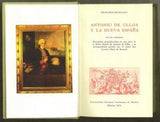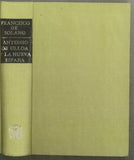Antonio de Ulloa y la Nueva Espana: Descripcion Geografico-fisica de una parte de Nueva Espana de Antonio de Ulloa, y su Correspondencia privada con el virrey don Antonio Maria de Bucareli
Author: Francisco de Paula Solano Pérez-Lila (1930-1996)
Year: 1979
Publisher: Universidad de Nacional Autonoma de Mexico (UNAM)
Place: Mexico City
Description:
clx+426 pages with frontispiece, tables, 20 plates (one folding), bibliography and indexes. Thick royal octavo (9" x 5") bound in beige cloth with black label and silver lettering to spine. Instituto de Investigaciones Bibliograficas Biblioteca Nacional de Mexico, Series Fuentes, number 2. Limited to 2000 copies. First edition.
This publication gathered facts and unpublished works of Antonio de Ulloa, one of the most relevant scientists and intellectuals of the Spanish Illustration. The present work rescues the mostly ignored brief presence (1776-1778) of this marine scientist in colonial Mexico and his scientific production through his documents: the study titled "Descripción de la Nueva España" and the transcriptions of his private correspondence (more than 150 letters) with Virrey Antonio Maria Bucarelli, archives kept at Real Academia de Historia (Madrid) and the Archivo General de Indias (Sevilla).
Antonio de Ulloa (1716-1795) was a Spanish general, explorer, author, astronomer, colonial administrator and the first Spanish governor of Louisiana. He was born in Seville, the son of an economist. Ulloa entered the navy in 1733. In 1735 he was appointed with fellow Spaniard Jorge Juan a member of the French Geodesic Mission, a scientific expedition which the French Academy of Sciences was sending to Ecuador to measure a degree of meridian arc at the equator, led by Pierre Bouguer. He remained there from 1736 to 1744, during which time the two Spaniards discovered the element platinum. In 1745, having finished their scientific labors, Ulloa and Jorge Juan prepared to return to Spain, agreeing to travel on different ships in order to minimize the danger of losing the important fruits of their labors. The ship upon which Ulloa was traveling was captured by the British, and he was taken as a prisoner to England. In that country, through his scientific attainments, he gained the friendship of the men of science, and was made a Fellow of the Royal Society of London. In a short time, through the influence of the president of this society, he was released and was able to return to Spain. He published an account of the people and the countries they have met (1748), which was translated into English as A Voyage to South America. He became prominent as a scientist and was appointed to serve on various important scientific commissions. He is to be credited with the establishment of the first museum of natural history, the first metallurgical laboratory in Spain, and the observatory of Cadiz. In 1758 he returned to South America as governor of Huancavelica in Peru and the general manager of the quicksilver mines there. He held this position until 1764. He arrived on 5 March 1766 in New Orleans to serve as the first Spanish governor of West Louisiana. The French colonists refused to recognize Spanish rule, and de Ulloa was expelled from Louisiana by a Creole uprising during the Louisiana Rebellion of 1768. For the remainder of his life he served as a naval officer. In 1779 he became lieutenant-general of the naval forces. As a result of his scientific work in Peru, he published (Madrid, 1784) Relación histórica del viaje á la América Meridional, which contains a full, accurate, and clear description of the greater part of South America geographically, and of its inhabitants and natural history. In collaboration with the Jorge Juan mentioned above, he also wrote Noticias secretas de América, giving valuable information regarding the early religious orders in Spanish America.
Condition:
Condition:
Slight binders damage to pages cxv through cxx, corners bumped. Jacket points and spine ends rubbed else a very good copy in better than very good jacket.
Jacket spine sunned, light edge wear, scuffed, hinges rubbed else very good in like jacket.













